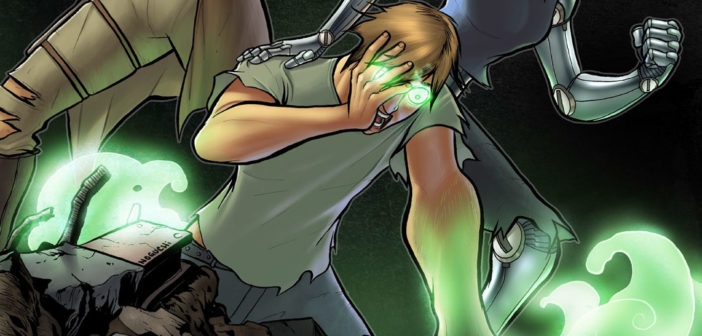I’ve come to the realization that most of the fiction I read today is from the comics medium. Prose in my life, save a few beloved novelists, has largely shifted towards nonfiction. There is no reasoning behind this, so much as it is an intimate and visceral response: I am a devotee of genre, and the visual nature of these stories is best served in comics.
I’m reminded of this by Mike Isenberg and Oliver Mertz’s First Law of Mad Science, a new independent book that debuted at this year’s New York Comic Con. I had a chance to speak with both Isenberg and Mertz there, and they were decked out in white lab coats while hovering around in their booth decorated like a makeshift laboratory. From what I saw, they drew a decent crowd.
Their book was still in the production stage during the convention, which is somewhat precarious on their part. They were selling little else than an idea—that and the promise to send out a PDF copy of the book to anyone kind enough to stop by the booth and show some interest. I was among those people, and I handed over my email address and card so I could see if their passion would pay off.
The PDF I was promised popped into my inbox a little over a week ago. While downloading it, I couldn’t remember a single word of creators’ pitch, and it was probably for the better. I prefer walking into an unknown book with my mind as a blank slate.
First Law of Mad Science quickly turned into a well-crafted science fiction epic powered by both enthusiasm and imagination. This is a book created by two people who love comics and have a story they don’t want to tell, but need to tell. And as science fiction goes, we’re set at some point in the future, though it’s difficult to tell when. The world created by Mertz and Isenberg is not unlike the world seen in Steven Spielberg’s Minority Report: futuristic buildings and vehicles line the horizon, but below them are suburban homes with children playing on the front lawns.
Our hero is George Baker and his son, Hank. George is a world-renowned inventor who is famous for his creation of the “tube-train system,” an advanced network of high-speed transportation, and R.A.C.H.I.E.L., a cybernetic woman who doubles as a family custodian and sibling. Believe me when I say she gives new meaning to Rosie the Robot.
George’s latest invention is cyber-eyes, which are exactly what they sound like: computerized eyes that are transplanted into willing recipients. Hank is among the first to receive the surgery, though the why isn’t explained. Was he blind, or perhaps have some kind of visually degenerative condition?
With the cyber-eyes comes the main thrust of the plot. Of course their defective—what good sci-fi story only has fully functional technology? Cyber-eye users begin seeing green, gelatinous creatures that folks with their original peepers don’t witness. What are these little monsters? Because this is only the first issue of what I assume to be a miniseries, we aren’t given a clue.
This is only the generalized premise of First Law of Mad Science. Writers Mertz and Isenberg have packed this issue with much sci-fi excitement—far too much to be explained without confusing everything. To be honest, I was a little confused during my reading. Sci-fi, no matter the medium or creators, usually begins with a lot of detail-heavy information, and as the plot progresses, the pieces of the narrative puzzle fall into place.
What’s strong here is the characterization. The players in this story are tangible and speak with personality. The interiors of artist Daniel Lapham buzz with the goings on of every page, and he keeps up perfectly with his ambitious writers. The same can be said for colorist Jeff McComsey, who contributes every perfect shade of black and white to this mystery. I adore black and white, and here is a sharp example of why.
Good science fiction is in limited supply these days, and it’s promising to see independent creators making a genuine effort to fill the void.
This comic book review originally appeared on Broken Frontier.




